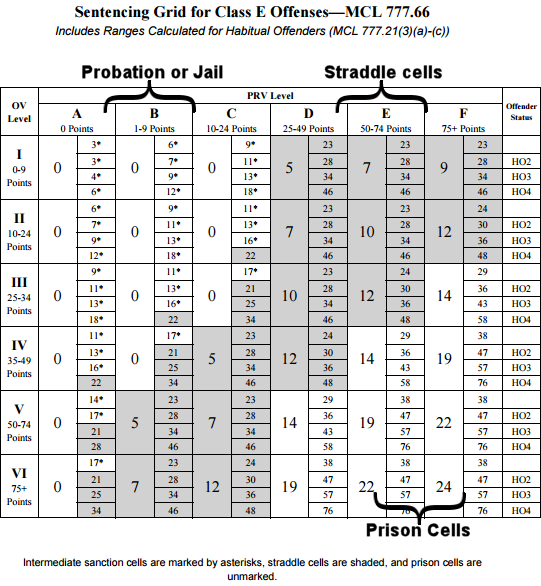I get a lot of telephone calls from people in a mad panic. For sure, there are a lot of crimes that mandate a prison sentence, but rest assured that you have to do some pretty bad stuff to land yourself in prison. Michigan voters want to be tough on crime, but Michigan taxpayers do not want to pay for an extended stay with the Department of Corrections.
In many felony cases, prison is not an option unless a person violates felony probation. For a first-time offender, a typical 5 year felony cannot result in a prison sentence under the Michigan Sentencing Guidelines without a violation of probation. By looking to the guidelines, you can get a good idea of possible exposure to imprisonment with the Michigan Department of Corrections. For example, a typical OWI 3rd offense carries a maximum possible penalty of 5 years in prison. This is a Class E felony, and the sentencing grid appears like this:

A typical third-time OWI offender is faced with his or her very first felony ever, with two misdemeanor convictions on record for OWI or OWVI. By being the third offense, an OWI 3rd qualfies as a felony, but it is the person's first felony offense. (This may not be true, and prior felony convictions can dramatically increase the PRV variables and add habitual offender enhancements.) But for the typical person charged with an OWI 3rd, a quick calculation of the guidelines will result in a sentence range of 0 to 9 months in prison, up to 5 years. This is a fictional prison sentence which calls for an "intermediate sanction." Intermediate sanction cells are those cells in which the upper limit recommended by the guidelines is 18 months or less. MCL 769.34(4)(a). These cells are marked with an asterisk in the sentencing grids. When an offender’s OV and PRV levels place him or her in an intermediate sanction cell, the court must sentence the offender to an intermediate sanction (which may include a jail term of 0-12 months or the cell maximum, whichever is less).
When a person has prior felonies, however, the guidelines might reach up into the shaded areas of the above chart. These are straddle cells. Straddle cells are those cells in which the lower limit of the recommended range is one year or less and the upper limit of the recommended range is more than 18 months. MCL 769.34(4)(c). Straddle cells appear shaded in the sentencing grids. When an offender’s OV and PRV levels place him or her in a straddle cell, a minimum sentence within the range indicated in the cell OR an intermediate sanction (which may include a jail term of not more than 12 months) is an appropriate sentence. Depending upon the court and the particular judge, a guideline range that falls within a straddle cell may result in a prison sentence.
Without a horrible prior record, it would be difficult to imagine a person exceeding a straddle cell on a Class E felony from our example, but it is remarkably easy to exceed a straddle cell on a 20 year Class B felony, such as "Delivering a controlled substance or GBL with intent to commit criminal sexual conduct." In the event that the PRV and OV place the defendant into a prison cell, the defendant is likely to go to prison unless his or her defense attorney can beat the charge or get a plea agreement to a less serious crime. Prison cells are those cells for which the minimum sentence recommended exceeds one year of imprisonment. Prison cells are those cells that are unmarked in the sentencing grids, i.e., not shaded (as are straddle cells) and not asterisked (as are intermediate sanction cells). When an offender’s OV and PRV levels place him or her in a prison cell, a minimum sentence within the range indicated in the cell is an appropriate sentence.
There are a number of offenses that do not fit neatly into the guidelines. For example, felony firearm carries a mandatory 2 year prison sentence. Similarly, going back to our example of an OWI 3rd, the statute requires that a person convicted of OWI 3rd shall serve at least 30 days in jail. Thus, nearly every person convicted of an OWI 3rd offense in Wayne County will serve 30 to 45 days in the county jail. Importantly, however, this is not prison! There is a world of difference between prison and jail, and it is almost always better for person to be ordered to serve a jail sentence over a prison sentence. Obviously, however, it is better still to avoid both options, so many people jump a little too quickly at a prosecutor's offer that would require only probation.
